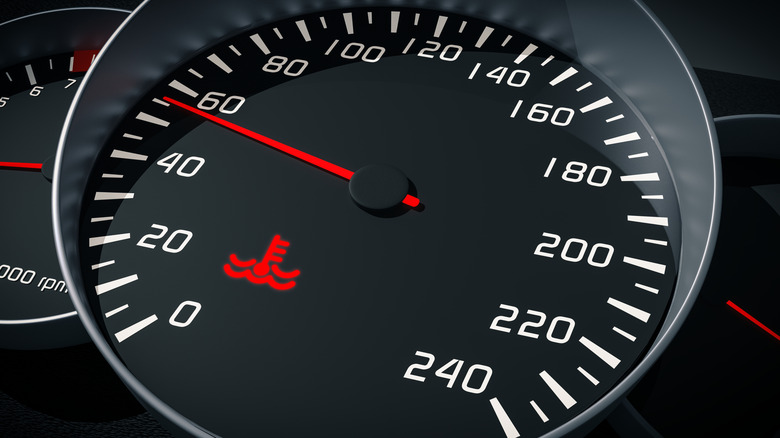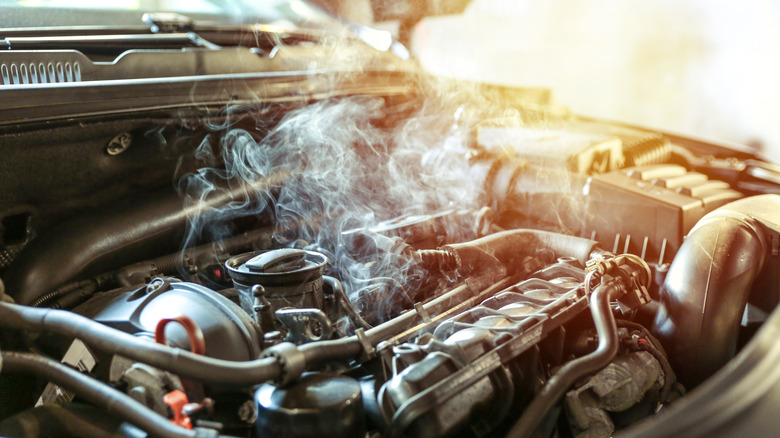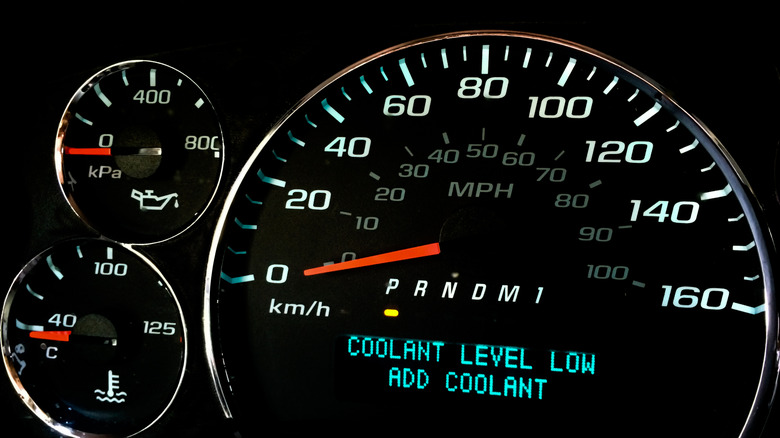Is It Safe To Keep Driving With The Low Coolant Light On?
Having worked in the motor trade for a good while, I have come across more than my fair share of warning lights on the dashboard. The chances are, everyone has come across a light on the dash at some point, and when it first happens, it can be a little daunting. The trick is to understand what each light means, so you know how to act. Some you can safely ignore for a short while, whereas others — like a flashing check engine light — are worth getting sorted pretty much immediately.
It wasn't uncommon for me to come across an old car with a traction control or airbag light on the dash, and, whether wise or not, I could happily ignore these for a short while. Sure, they need sorting, but I figured it was fine for me to at least continue my journey if one of these lights popped up on the dash. However, if a low coolant light ever jumped up on the dash, I would act a little differently. Rather than just logging it in my mind and carrying on, I would find somewhere to stop and then investigate a little further before driving on again. So, to answer the question posed by the heading directly, no, in my opinion, it is not safe to drive with the low coolant light on, and here's why.
This is why you should not ignore a low coolant light
Engine coolant serves a pretty important function, and for the uninitiated, its main function is to keep your engine operating within its optimal temperature range. Coolant flows through your engine bay while you're driving, and this helps to keep your engine from overheating. If there is too much coolant in the system, you run the risk of bursting a pipe and soaking your engine bay in hot coolant. However, if there isn't enough coolant in the system, then your engine will be at risk of overheating, and that can very easily lead to significant and permanent damage. So, it's imperative to ensure you have the right amount of coolant in your system.
If your coolant level does drop too low, then a low coolant light should illuminate on your dashboard. That light may be red, and if it is, this usually signifies that the engine is running hot, too. This is your car's way of saying there isn't enough coolant for it to efficiently regulate the engine's temperature, and to pull over, inspect, and address the situation. When your coolant is low, the engine can quickly rise in temperature, and this can lead to head-gasket failure, and even the warping of your cylinder head. At this point, your engine really is living on borrowed time, and some modern cars may even shut down automatically as a protection measure. You also run the risk of damaging other engine components, such as the water pump, thermostat, and radiator.
Why is your low coolant light on?
Once you have found a place to stop, it's time to investigate the light. First of all, do not open the radiator or expansion tank — coolant runs hot, even when there's enough in there, and the last thing you want is pressurized coolant burning your skin. Begin by popping the hood to allow for improved ventilation for the potentially very hot engine. Now is a good time to have a look at the reading on your expansion tank. You're supposed to take the reading when cold, but at least you can check to see if there's any in there or not. Next, take a good look around for signs of a potential leak. This is a common cause for low coolant — has an old rubber pipe cracked, split, or burst? If not, did you see any white smoke pouring from your exhaust when it was running? White smoke could be a sign of coolant burning, which should not be happening — this will need further diagnosis.
If there is no sign of a leak, the exhaust isn't throwing white smoke out, and the level is where it should be on the expansion tank, then perhaps you're lucky and it's just the sensor for reading the coolant level that's failed. Don't bet on it, though. Have your car checked out by a mechanic just in case you've missed something a little more troublesome.


